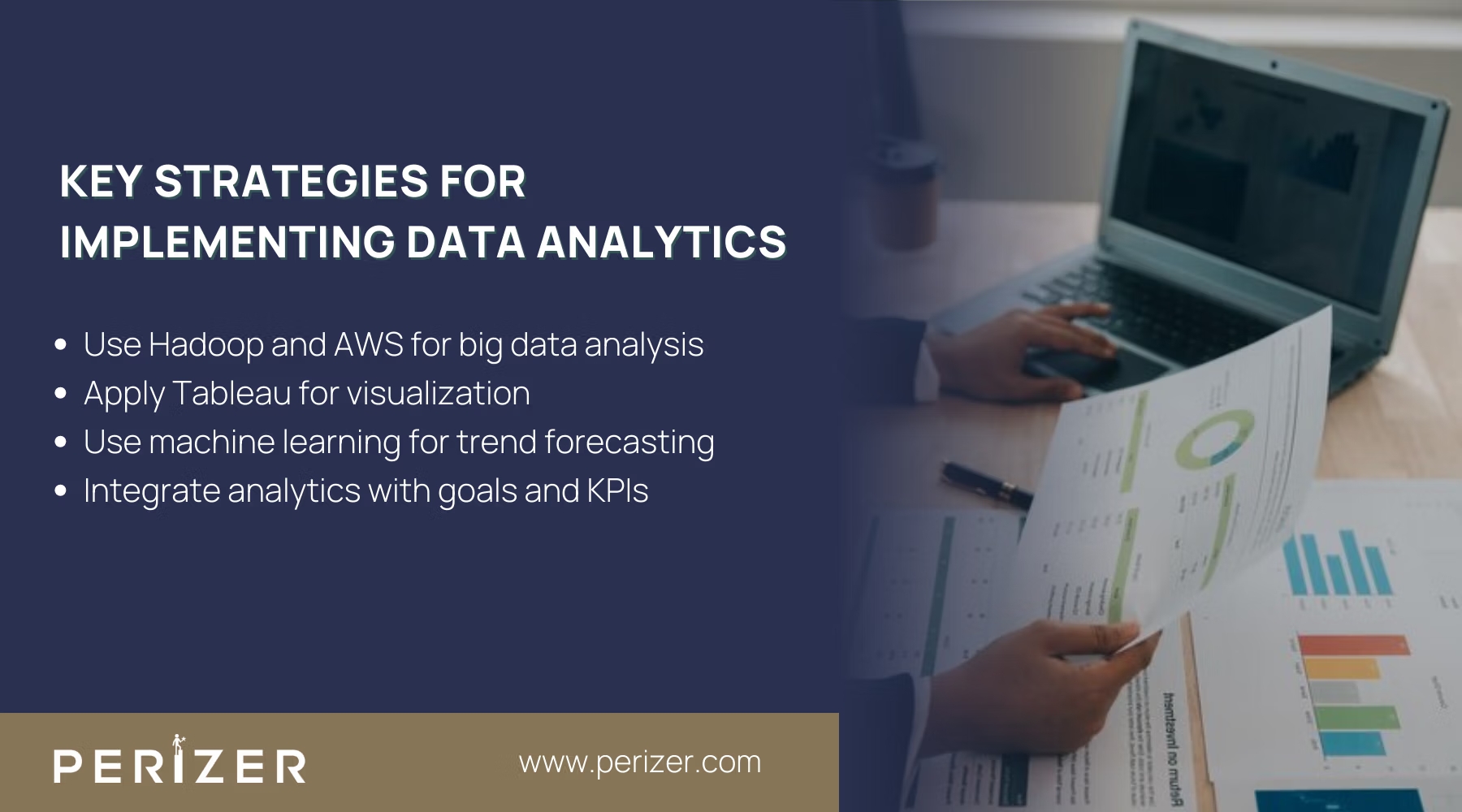How to Use Data Analytics for Business Growth
Transform your business with cutting-edge data analytics techniques. Explore emerging tech and strategic alignment to fuel growth and innovation.

Imagine being able to predict what your customers want before they even know it themselves or spotting market trends just as they start to emerge. This isn’t some distant future scenario; it’s the present for businesses that truly understand how to use data analytics. In today’s world, data isn’t just an afterthought - it’s your most valuable asset for making smarter decisions and outpacing the competition.
In this guide, we’ll explore how you can use data to make better decisions and drive growth in your business. Let’s unlock the full potential of your data together.
Key Strategies for Implementing Data Analytics

1. Big Data Analytics for Strategic Decision-Making
Big data analytics offers the potential to transform business strategies by providing valuable insights. By analyzing large volumes of data, you can see trends that are not visible. For example, retailers can identify purchasing patterns that help them create their marketing strategies. Meanwhile, manufacturing companies can optimize their supply chain by predicting demand fluctuations.
How Can You Transform Business Strategies Using Big Data?
To transform your business strategies with big data, start by identifying the key metrics that matter most to your objectives. Focus on gathering data from customer interactions, sales reports, and market trends using advanced tools. Once you have the data, use analytics to uncover patterns and gain actionable insights. The real magic happens when you use these insights to make informed, strategic decisions. Keep refining your approach as new data rolls in, so you stay ahead of the competition.
Tools and Techniques for Implementing Big Data Analytics
Implementing big data analytics effectively means selecting tools that handle large datasets with powerful analytical capabilities. Open-source platforms like Hadoop and Spark offer distributed storage and processing, enabling efficient management of massive datasets.
Cloud-based solutions such as AWS, Microsoft Azure, and Google Cloud provide scalable resources for data storage, processing, and machine learning, making it easier to extract insights as your data needs grow. Additionally, data warehousing solutions like Snowflake and Redshift facilitate storing large volumes of data and executing complex queries, providing a structured environment for advanced analytics.
2. Advanced Data Visualization Techniques for Reporting
Data visualization is an essential tool for communicating complex data. It converts raw data into visual representations, making it easier for decision-makers to understand patterns and trends. For instance, a well-crafted dashboard can highlight key performance indicators (KPIs), enabling you to monitor business health at a glance.
1. Use data visualization to simplify complex data sets, making them accessible to all stakeholders.
2. Visualize data to uncover insights that drive strategic decisions. Use graphs, charts, and heat maps to convey critical information effectively.
3. Facilitate communication between departments by presenting data in a visual format. This enables cross-functional teams to collaborate more effectively and make informed decisions.
Choosing the Right Visualization Techniques and Tools
Choosing the right visualization techniques and tools is important for effectively communicating data insights. For example, heat maps are great for highlighting areas of interest and are especially useful for visualizing geographical data or the intensity of specific metrics. Geospatial analysis offers insights into geographical trends and is ideal for businesses with a regional or global presence.
Interactive dashboards allow users to explore data dynamically, providing deeper insights through drill-down features. Time-series analysis helps visualize trends over time, tracking changes in business metrics and identifying long-term patterns.
To implement these techniques, you can use tools like Tableau, which offers interactive visualizations with a user-friendly interface, Power BI, which enables rich, interactive reports and integrates with various data sources, and D3.js, a flexible JavaScript library for creating custom visualizations.
3. Implementing Predictive Analytics
Predictive analytics gives you the power to anticipate future trends and make proactive decisions that can significantly benefit your business. By analyzing historical data, you can spot patterns that reveal what’s coming next, allowing you to adapt your strategies and stay ahead of the competition.
For instance, you can forecast market trends and consumer behavior to align your business tactics with shifting demands. Predictive insights also help you uncover untapped markets or customer segments ripe for growth, giving you a clear path to expansion.
Moreover, predictive models can identify potential risks, enabling you to implement preventive measures and avoid costly surprises. With predictive analytics, you can confidently navigate the business landscape, turning data into a strategic asset that fuels growth and innovation.
Advanced Guide to Effective Predictive Modeling
To truly use predictive analytics, you need a mix of advanced techniques and industry know-how. Start by using machine learning algorithms like decision trees, neural networks, and random forests to see hidden patterns and make accurate predictions. These tools are vital for identifying trends and insights that traditional methods might miss.
Regression analysis is your go-to for understanding how variables interact and influence each other, providing valuable info for strategic decisions. Time-series forecasting is important for predicting trends over time, whether you're looking at sales projections or demand planning.
Clustering and segmentation are key to understanding your customer base. By grouping similar data points, you can pinpoint distinct customer segments and create your marketing efforts to meet your unique needs, improving engagement and conversion rates.
To ensure your predictive models are accurate and reliable, prefer data quality. Clean, consistent data is significant for effective modeling. Validate your models by testing them against historical data and use cross-validation techniques to fine-tune them. Regular monitoring is essential; as new data comes in, update your models to keep them relevant and effective.
4. Integrating Data Analytics into Business Operations
Integrating data analytics into your business operations means ensuring that your analytical efforts are in sync with your organization's goals. Start by clearly defining your business objectives, as this creates a framework for aligning your data analytics initiatives with your overall strategy.
Identify key metrics that reflect these goals, and use them to guide your data collection and analysis efforts. It's important to build a data-based culture within your organization by promoting data literacy and encouraging data-based decision-making at all levels. Collaboration across departments is also essential; by working together, cross-functional teams can share insights and drive innovation, seamlessly integrating data analytics into everyday workflows.
Effective Data Analytics Implementation
When implementing data analytics solutions, several key factors ensure success and drive business growth. First, establish robust data governance policies to maintain data quality, privacy, and security. This ensures the integrity of your analytics efforts and compliance with relevant regulations, especially when handling sensitive information. Involving stakeholders early in the implementation process is also important, as their support and buy-in can lead to more successful adoption and integration of data analytics solutions.
Investing in the right technology infrastructure is essential, including data storage solutions, processing capabilities, and analytical tools that support your initiatives. To measure the impact of these efforts, define clear key performance indicators (KPIs) that align with your business goals. Regularly track these metrics to evaluate performance, identify areas for improvement, and optimize strategies. Additionally, assessing the return on investment (ROI) helps determine the value of your analytics initiatives, justifying ongoing investment. By considering these elements, you can effectively implement data analytics and enhance business performance.
Conclusion
Data analytics provides the tools and techniques needed to drive meaningful business growth. By using big data, advanced visualization methods, and predictive analytics, you can gain insights that lead to informed and strategic decisions.
Successfully incorporating data analytics into your operations requires thoughtful planning and aligning your business goals. As new technologies continue to emerge, staying ahead of these advancements is important for maintaining your competitive edge. By treating data analytics as a strategic asset, you can unlock new opportunities for growth and innovation, ensuring your business grows in the long run.
FOCUSED, FAST, GOVERNMENT READY
Stay Tuned With Our Latest Insights

Staff Augmentation
Learn how to select the perfect IT outsourcing partner to promote your team’s capabilities, improve productivity, and drRead more...

Staff Augmentation
Find the perfect staff augmentation partner by aligning your goals, evaluating expertise, managing costs, and ensuring aRead more...

Cyber Security
We focus on understanding the needs, behaviors, and expectations of your users through extensive user research. This infRead more...